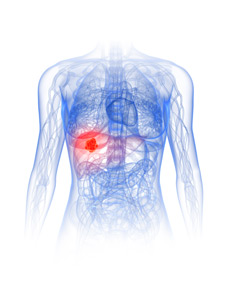About the Liver and Bile Ducts
 The liver is the largest and most important solid organ in the body, serving four very important functions:
The liver is the largest and most important solid organ in the body, serving four very important functions:
- Receives and processes all of the blood and nutrients absorbed from the intestines. Any toxins absorbed from the intestine are neutralized in the liver.
- Produces bile that is emptied into the intestine through bile ducts that connect the liver to the intestine. The bile is required to help the intestines digest all of the food you eat.
- Produces almost all of the proteins found in your body. These proteins assist your body in performing many of its important functions like clotting blood after an injury or fighting off infection.
- Detoxifies waste products produced by muscle and other organs.
One of the most remarkable functions the liver performs is regenerating itself. If it is damaged or a portion is surgically removed, it will grow back to its normal size and function ability in a few weeks. This is extremely important for our living liver donors.
Liver failure occurs when the liver can no longer perform its many functions. You may experience fatigue, weakness or confusion. Fluid may build up in your legs and abdomen, and you may develop bleeding in your stomach.
Many diseases and conditions can cause liver failure. The most common disease that leads to liver failure is chronic viral hepatitis. Other common reasons for liver failure include chronic non-viral causes of hepatitis, chronic cholestatic liver disease and fulminant (acute) hepatic failure.
Any of these conditions may be cause for liver transplantation.
Chronic Liver Disease and Cirrhosis
Chronic liver diseases cause liver failure by damaging the liver over several decades. This type of liver failure is usually irreversible. Chronic liver diseases may progress to cirrhosis, which develops when normal liver cells are damaged, die and then are replaced by scar tissue. Because there are fewer healthy liver cells, the liver cannot work properly. However, only a minority of patients with these chronic liver diseases progress and develop cirrhosis.
Chronic liver diseases include:
- Cholestatic liver diseases, which usually involve problems with the excretion of bile from the liver.
- Primary biliary cirrhosis
- Primary sclerosing cholangitis
- Secondary biliary cirrhosis
- Biliary atresia
- Alagille's syndrome
- Hepatocellular liver diseases, which involve damage to liver cells.
- Chronic viral hepatitis (hepatitis B, C, D)
- Autoimmune hepatitis
- Alcoholic liver disease
- Steatohepatitis (fatty liver)
- Cryptogenic cirrhosis
- Vascular diseases, which occur when the blood does not drain through the liver properly. This causes the liver to swell and malfunction. This process occurs with Budd-Chiari syndrome and veno-occlusive disease.
- Fulminant (acute) hepatic failure, which occurs suddenly and is severe. Liver failure progresses rapidly, and without transplantation the death rate is high. Fulminanthepatic failure may be caused by:
- Viruses
- Wilson's disease
- Exposure to drugs or environmental toxins
- An unknown cause (about 20 percent of patients)
- Liver tumors, also called hepatocellular carcinomas, for which transplantation may be considered as treatment.
- Metabolic disorders that cause cirrhosis and liver failure. Liver transplantation can usually cure metabolic or genetic diseases such as:
- Alpha-1-antitrypsin deficiency
- Wilson's disease
- Hemochromatosis
- Tyrosinemia
- Glycogen storage disease
Bile Duct Cancer (Cholangiocarcinoma)
Cholangiocarcinoma is a rare cancer that originates in the bile ducts, or ducts that drain bile from the liver and gallbladder into the small intestine. Surgical removal of the cancer can be an option for some patients, but often not for those who are diagnosed a later stage.
In patients whose cancer is more advanced, complete liver transplantation may be an option. During the transplantation surgery, the patient's liver and bile ducts are removed and replaced with a donor's liver and ducts. In many cases, liver transplantation for cholangiocarcinoma is used in conjunction with radiation and/or chemotherapy treatments to minimize the chance of recurrence after transplant. The renowned surgeons of the Hume-Lee Transplant Center have a depth of experience in complex liver and biliary surgery that allows us to be one of only a few transplant centers in the nation able to offer liver transplant for the treatment of bile duct cancers.

